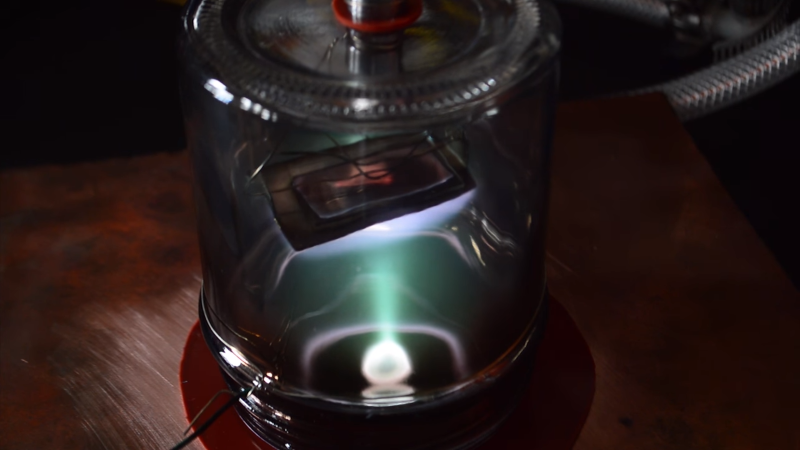“You can never be too rich or too thin,” the saying goes, and when it comes to coatings, it’s true that thinner is often better. The way to truly thin coatings, ones that are sometimes only a few atoms thick, is physical vapor deposition, or PVD, a technique where a substance is transformed into a vapor and condensed onto a substrate, sometimes using a magnetron to create a plasma.
It sounds complicated, but with a few reasonable tools and a healthy respect for high voltages, a DIY magnetron for plasma sputtering can get you started. To be fair, [Justin Atkin] worked on his setup for years, hampered initially by having to settle for found parts and general scrap for his builds. As with many things, access to a lathe and the skills to use it proved to be enabling, allowing him to make custom parts like the feedthrough for the vacuum chamber as well as a liquid-cooled base, which prevents heat from ruining the magnets that concentrate the plasma onto the target metal. Using a high-voltage DC supply made from old microwave parts, [Justin] has been able to sputter copper films onto glass slides, with limited success using other metals. He also accidentally created a couple of dichroic mirrors by sputtering with copper oxides rather than pure copper. The video below has some beautiful shots of the ghostly green and purple glow.
A rig such as this opens up a lot of possibilities, from optics to DIY semiconductors. It may not be quite as elaborate as some PVD setups we’ve seen, but we’re still pretty impressed.

















Yay, been considering solid electrolyte films for various gas experiments, interesting stuff, thanks for post :-)
FWIW, DC sputtering is only good for sputtering metals. Dielectric materials build up a charge on the surface which screws up the process. For dielectric materials you use RF.
And please get a real vacuum chamber. Drilling though and using a jar like that is just asking for an implosion. You can get pyrex or polycarb bell jars off amazon. Or do like the sputter coaters for SEMs do and use a glass cylinder with metal tops and bottoms. Flat glass surfaces and vacuum do not mix.
do you think that a polycarb bell jar would survive the temperatures involved in sputtering?
Have you ever seen a cd? or sunglasses?
I want to see someone DIY thick aluminum coating, like is used for “chrome” parts in plastic model kits and on automotive trim.
This was particularly interesting because I’m about to do this on an industrial scale, sputtering gold onto a plastic film. I was surprised that you ended up with a copper plasma, since I understood that the plasma was Argon only. I do wonder if the typical argon gas flushing is what prevents a buildup of vapor from the substrate. Also, the fact that you appear to have deposited an oxide is a little surprising. Normally, DC sputtering is not used for sputtering insulating materials (RF is), but here you don’t actually have an insulating material: you have copper. I can’t quite see how the oxide is formed without something charging up. Watching this, I am reminded that this process is “black magic”. Perfectly good physics, but a lot of it, and much of it not obvious. Thanks!
Hi Paul,
I am learning about sputter vapor deposition of Gold/Silver/Copper metals and it is apparently a poor choice to apply them directly to an oxide, silicon, or insulating base layer. I am leaning towards an adhesion layer of Chromium (or Titanium, Tungsten, or Niobium) prior to Silver in my case. Silver, Gold, and Copper will apparently fail if electrically charged or heated, or even repeatedly flexed on a dielectric material such as Kapton (secretly just a layer of polymerized dried paint).
Peep this! https://www.sciencedirect.com/topics/engineering/adhesion-layer
So Chromium is a large molecule that has high Oxygen reactivity, and both self-passivates with residual chamber Oxygen and also de-passivates oxide films – promoting greater adhesion. Some caution needs to be observed when applying to Aluminum or Carbon however., implying one of the other adhesion elements (perchance Titanium) may offer superior performance.
I also learned about islands forming in the Au film in the initial thin layers. The adhesion layer suppresses the formation of these island features resulting in a more uniform Au layer. Diffusion of the Cr layer into the Au film will occur over time resulting in an AuCr alloy, but the technique here is to have as large an Au top layer to Cr adhesion layer ratio as the application permits, thus delaying and reducing the impact of the diffusion.
Good luck!
you might find this article interesting. https://www.sciencedirect.com/science/article/abs/pii/S0257897207011668 the idea of chemically activating the glass for electroless gold nano particle coating.